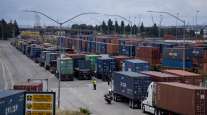Truck Turn Times Up One Minute in June as Cargo Volumes Grow Again at L.A., Long Beach Ports

The average time it took a trucker to enter and exit the ports in Los Angeles and Long Beach, Calif., inched up one minute in June from the same month in 2016, although data from the Harbor Trucking Association revealed encouraging signs that drivers are moving quicker than a year ago.
Meanwhile, cargo volumes continue to surge in 2017 at the two top ports in the United States.
The combined average in Los Angeles and Long Beach was 83.5 minutes in June. At the Port of Los Angeles, it was 87 minutes and at the Port of Long Beach, it was 80 minutes. HTA produces the data using GPS technology and geofencing to measure the time between when a truck enters the queue to the entrance and when it crosses the exit gate.
However, comparing each terminal in June 2017 with 2016, the story is quite positive for the trucking community. Out of seven terminals in Long Beach, five were quicker than a year ago and although a sixth — the Matson terminal — was five minutes slower at 40 minutes, it was still half the average turn time portwide. Out of seven terminals in Los Angeles, four were quicker than a year ago, while two others were slower but still quicker than the 87-minute average.
The Middle Harbor terminal in Long Beach had the second-fastest time behind Matson, averaging 47 minutes. Yusen Terminals International topped the list in Los Angeles at 66 minutes.
The longest turn time for draymen was 114 minutes at Total Terminals International in Long Beach, although HTA believes the cyberattack affecting A.P. Moller-Maersk skewed the data because at least one vessel — the MSC Lauren — was diverted from APM Terminal-Pier 400 in Los Angeles to Total Terminals. Maersk operates APM Terminals and MSC is the majority owner of Total Terminals and the two steamship lines share cargo under the 2M Alliance.
In Los Angeles, the APL-Eagle Marine Services terminal was the slowest, deteriorating to an 112-minute average compared with 49 last June. CMA CGM Group, a member of the Ocean Alliance with Cosco Shipping, Evergreen Line and Orient Overseas Container Line, committed to steering more cargo to its APL subsidiary terminal this year.
Last month, Los Angeles terminals handled 731,032 industry-standard 20-foot equivalent units, or TEUs, an 8.1% increase from one year ago. Loaded import containers grew 4.7% to 372,272 and exports increased 3.5% to 145,527 at the largest port in North America based on annual container volume.
“As we mark the midpoint of 2017, we are grateful to our terminal operators, shipping lines, labor force and land-side supply chain stakeholders for their focus on teamwork and efficiency, because they are the reason why we attained record-breaking volumes these past 12 months,” said Gene Seroka, executive director of the Port of Los Angeles. “Despite unprecedented change in our industry, we are demonstrating the L.A. Advantage in terms of world-class infrastructure, competitive pricing and extraordinary customer service.”
Through the first six months, the Port of Los Angeles processed 4,482,548 TEUs, up 8.4% from 2016 when the complex set a record for the Western Hemisphere, a mark it appears on its way to shattering again.
Cargo volumes in Long Beach climbed 9.2% year-over-year to 658,727 TEUs, the second-best June in history. For June, loaded container imports grew 7% to 335,328 TEUs but loaded exports declined 7.6% to 118,304 at the second largest port in North America.
Through the first half of 2017, container throughput rose 5.1% to almost 3.5 million.
“These are good results as we move into the busiest trade months of the year,” Harbor Commission President Lori Ann Guzmán said. “The U.S. dollar remains strong and retailers are stocking back-to-school merchandise and other goods American consumers are purchasing.”
“It’s good to see this evidence of their confidence in our port — we are committed to providing the absolute best service in the country,” Executive Director Mario Cordero added.
HTA Executive Director Weston LaBar said he is especially pleased to know that turn times were quite positive for the trucking industry, even though ports are moving more containers through their terminals.
“You always like to see better turn times with more volume because it shows the terminal operators are putting efficiencies in place to help truckers. So it’s great news and a trend that we hope continues because it’ll make the area more attractive for discretionary cargo that’s up for grabs between the West Coast, Gulf Coast, East Coast and even Canadian ports,” he said.
Meanwhile, trucking industry executives will review a draft of the Clear Air Action Plan, calling for the introduction of three next-generation yard tractors, a pilot program to test 50 to 100 zero-emissions drayage trucks, opening a large near-dock peel-off yard, accelerating use of LED lights portwide and assessing opportunities to deploy zero and near-zero cargo handling equipment at all terminals.




